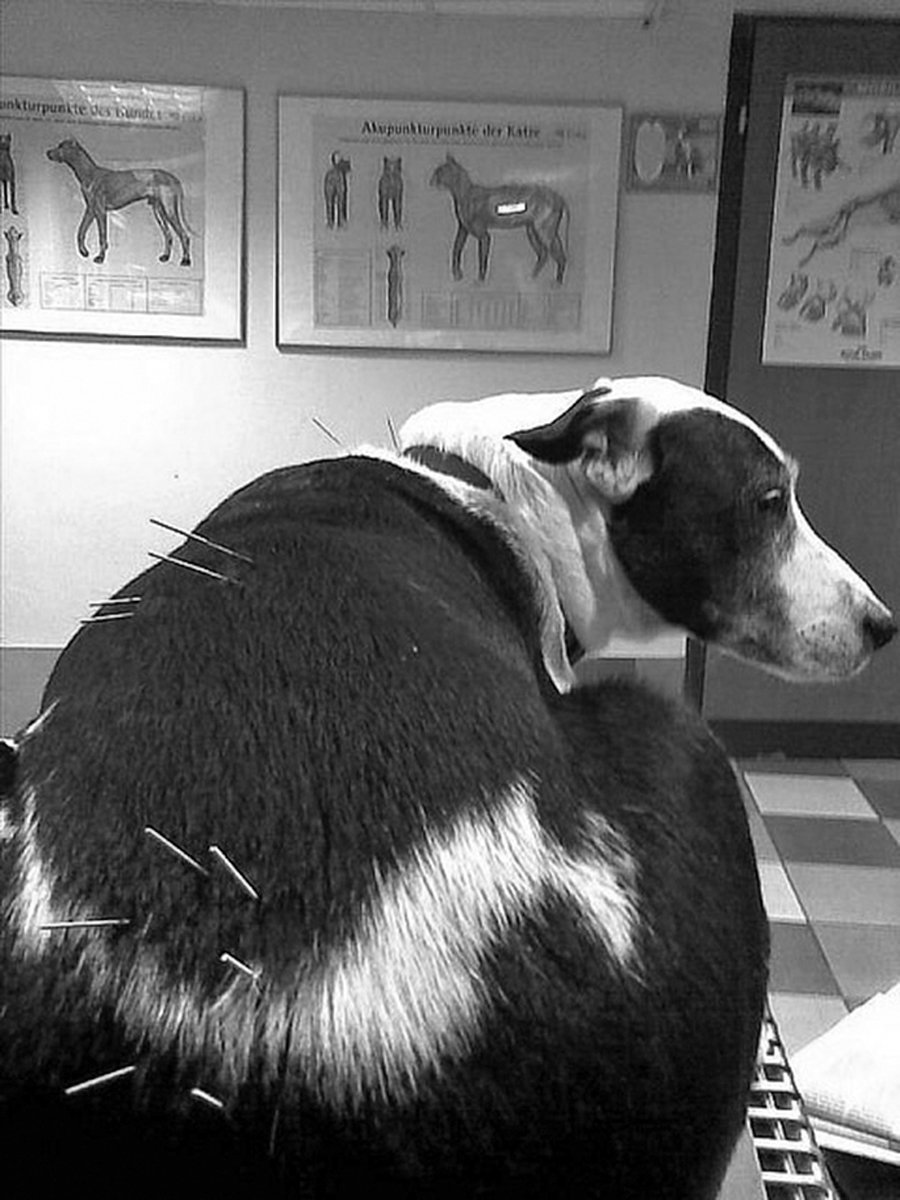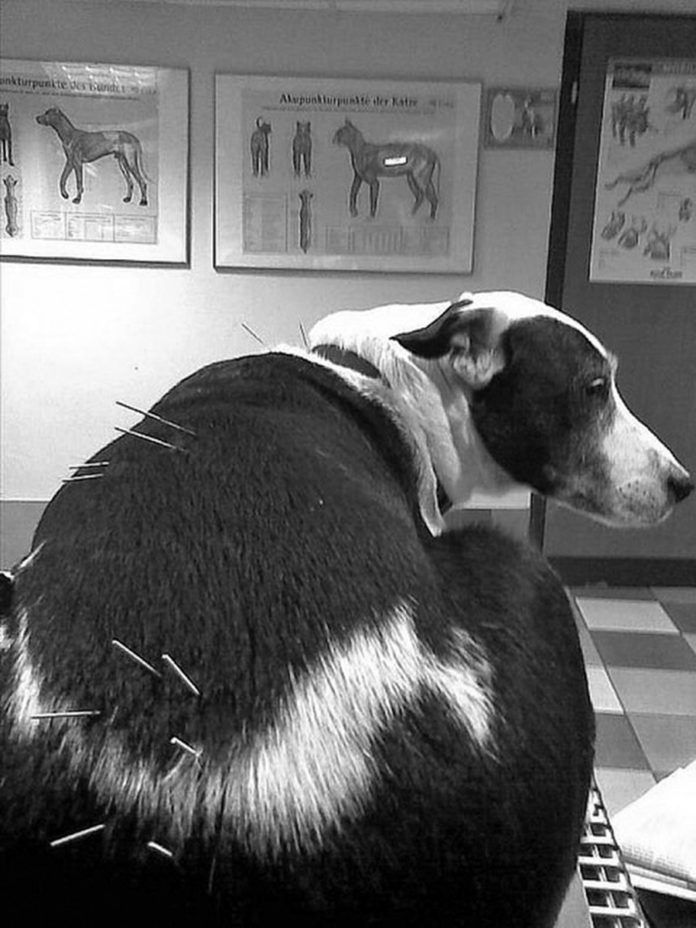At two and a half years old, Scout was having unexplained seizures. “They were very difficult to control,” says his owner, Deborah Prevratil. “He was on standard phenobarbital” and other medicines and still, “we averaged anywhere from four seizures a day down to one.” But after working with a veterinarian schooled in acupuncture, Scout went down to one seizure every two weeks. “Right now he has been seizure-free for more than three months,” says Ms. Prevratil. “Three months doesn’t sound like a long time,” she adds, “but after grand mal seizures and seizure clusters,” it’s a huge relief.
Scout’s doctor, Richard Schafer, DVM, isn’t surprised at the dramatic results. “I was very skeptical” about acupuncture in veterinary school, he says. But Dr. Schafer happened upon a horse who was paralyzed across half his face for whom traditional Western medical treatments had done nothing. After one week of acupuncture, however, the paralysis was 75 percent gone. At the end of the second week,” Dr. Schafer says, “the horse was 100 percent normal.”
Dr. Schafer is a big enough believer that today, some 30 years later, he is the treasurer of the International Veterinary Acupuncture Society (ivas.org) and heads the acupuncture course taught to veterinarians, upon completion of which they receive certification (once they pass both a clinical and written exam).
Michael Petty, DVM, the immediate past president of the International Veterinary Academy of Pain Management (ivapm.org), had a similar experience. “Even as I was putting the needles in when I first started practicing acupuncture,” he comments, “I would say, ‘This is never going to work.’ But I’ve seen absolutely dramatic changes, sometimes after one session. I had one client walk back in after a session and say, ‘My dog has been unable to jump into my truck for the last three years. One treatment, and he jumped in. Three hundred years ago, they would have burned you for witchcraft.”

Acupuncture for dogs is definitely gaining ground. Not only are more and more veterinarians learning the Eastern technique, but the International Veterinary Academy of Pain Management’s Board of Directors voted just last month to adopt a position statement on acupuncture that endorses its use for certain conditions, virtually all having to do with pain — everything from pain due to soft tissue injury to post-operative surgical pain. “Where acupuncture shines is really in the pain field,” says the Academy’s Dr. Petty. Momentum for use of acupuncture to relieve pain is reflected in the fact that more and more pet health insurance companies are reimbursing for acupuncture treatments (which can easily cost $80 a session, if not more).
Acupuncture’s uses in dogs
“Acupuncture works on things that Western medicine doesn’t work very well on,” the International Veterinary Acupuncture Society’s Dr. Schafer says. His list includes relief from arthritis pain (that’s “probably the big one” in terms of treatment on dogs, he comments); intervertebral disk disease in a dog’s back (especially if surgery is not an option); the nausea and other side effects that come from cancer treatments like chemotherapy and radiation; and even diarrhea and constipation. The International Veterinary Acupuncture Society also mentions skin problems such as lick granulomas and allergic dermatitis, in addition to a number of other ailments.
Of course, it’s not an either/or when it comes to acupuncture and Western medicine. If someone tells you it is, you should not put your dog in his or her care. A conscientious veterinarian who practices acupuncture will use both Western and Eastern applications to effect the best pain relief possible. That is, the treatments are synergistic rather than exclusive. For arthritis pain, for example, perhaps the best relief for a dog will be a combination of nonsteroidal anti-inflammatory drugs (NSAIDS), supplements of glucosamine and chondroitin, pain medication, weight control, exercise moderation, and acupuncture.
Do make sure the person performing acupuncture on your dog is a veterinarian. “A pure acupuncturist could miss something that could very easily be cured by Western medicine,” Dr. Schafer points out. Not only do “you have to know that there are certain things Western medicine is going to work better on,” he continues. You have to be able to “translate from bi-ped to quadruped,” meaning that acupuncture points are not always transferable from human to dog. It takes a veterinarian who understands canine anatomy to find the relevant acupuncture points.
Acupuncture’s ins and outs
In traditional Chinese medicine,” Dr. Schafer explains, “there are 12 meridians, or channels, in the body that someone performing acupuncture tries to affect. Each of these meridians has different acupuncture points, and they all do different things.” That means that for each, you get a “different effect from the needles.” Still, as a whole you are looking to do somewhat similar things with each acupuncture needle: send increased blood supply to an area you want to treat and elicit a stimulation response so that nerve impulses travel up to the brain and then back down to whatever tissues you’re trying to influence. Nudging blood to a specific area allows it to nourish damaged tissue and also carries away some of the degradation products involved in certain disease processes, Dr. Schafer says. And manipulating nerve impulses allows for the release of endorphins and other endogenous opioids that relieve pain.
Many of the effects can be explained in Western medicine’s terms. The channels “follow major nerve and blood vessel routes,” says Dr. Petty of the International Veterinary Academy of Pain Management. For instance, “they follow the sciatic nerve, along the spinal chord.” So it would make sense that manipulating those areas would have an effect.
“When you put the needle in you also twist it,” he explains further. “The zing felt by the dog [or person] is that you grabbed a bunch of collagen fibers and wound them up. So you change tissue, literally. When you distort the collagen fibers, it causes all sorts of reactions on a biochemical level, a neurological level.”
This has been proven. Research has shown that acupuncture activates brain sites involved in pain, illustrated by brain imaging studies. Parts of the brain “light up,” so to speak. And with the help of single-photon emission computed tomography, in scans evaluating cerebral blood flow, it has been seen that acupuncture to reduce pain alters activity in the frontal lobes, brain stem, and thalamus.
Because acupuncture affects both the flow of blood and nerve impulses, the needles often go where there’s a “confluence of nervous tissue,” Dr. Schafer says, along with “muscle and tendon insertion points, ligaments, and blood vessels and lymph.” In other words, one needle is impacting several systems at once.
The gold-standard scientific evidence for the effects of inserting acupuncture needles into key points is not where veterinary researchers would like it to be. While there is definitely evidence that acupuncture affects nerve impulses and can cause the release of certain brain chemicals, it has not been proven empirically that acupuncture relieves pain and treats diseases as well as some claim. Where the claims are particularly out in front of the evidence is in the realm of behavioral issues,” Dr. Petty says, “along the same lines as in people — things like weight loss in humans. They try acupuncture all the time with weight loss, and it doesn’t work.” Similarly, there’s no evidence it’s going to get a dog to behave differently. You’re not going to get Fido to stop jumping on people by sticking needles in his channels.
Even where the evidence for acupuncture is on more solid ground, it’s not as solid as for many treatments now proven for Western medicine. Part of it is that it’s hard to control for the placebo effect. “A sham acupuncture point” that’s supposed to act as a placebo may be “just an inch away from the real one,” Dr. Petty says. “And it’s kind of like horseshoes. You might get it right around the stake,” but even if you get it sort of around the stake, it still counts — “you’re still going to get results, so it’s very difficult” to test acupuncture’s impact against that of a placebo. Because of challenges such as that, the International Veterinary Acupuncture Society says plainly on its website that “although many of acupuncture’s physiological effects have been studied, many more are still unknown. Further research must be conducted….”
That said, the pet-owning community is rife with stories of animals in intractable pain who finally found relief with acupuncture when a bevy of traditional treatments couldn’t help. Deborah Prevratil’s story of Scout and his diminishing seizures is but one of many. (She was so taken by his turn-around that it is no accident she became the executive director of the International Veterinary Acupuncture Society a few months ago.)

What we like is that while certain claims may outstrip the evidence, acupuncture is unlikely to do any harm. If your dog is in significant pain or discomfort and none of the conventional treatments has provided enough relief, you have little to lose by giving veterinary acupuncture a try — as long as your dog is still being treated by a veterinarian who understands canine physiology and disease processes.





